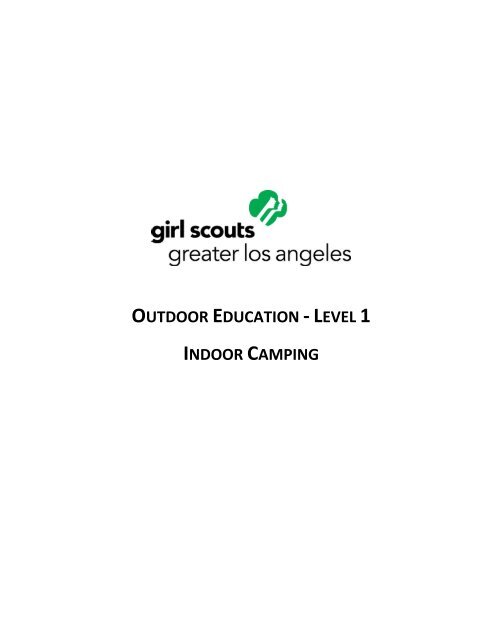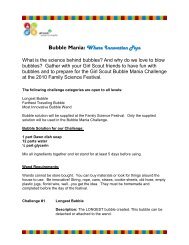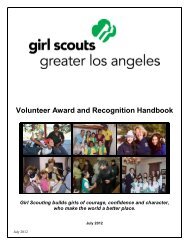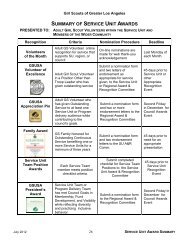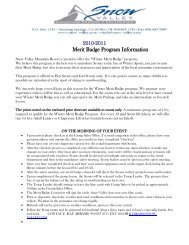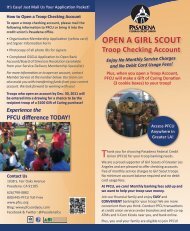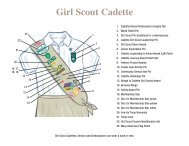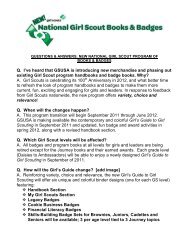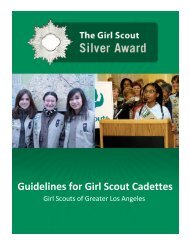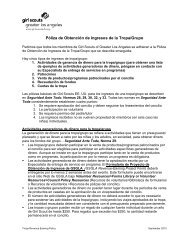OUTDOOR EDUCATION LEVEL 1 - Girl Scouts of Greater Los Angeles
OUTDOOR EDUCATION LEVEL 1 - Girl Scouts of Greater Los Angeles
OUTDOOR EDUCATION LEVEL 1 - Girl Scouts of Greater Los Angeles
Create successful ePaper yourself
Turn your PDF publications into a flip-book with our unique Google optimized e-Paper software.
<strong>OUTDOOR</strong> <strong>EDUCATION</strong> - <strong>LEVEL</strong> 1<br />
INDOOR CAMPING
MY NOTES<br />
Our thanks to Ted Oyama, Troop Leader and Adult Learning Facilitator, who created many <strong>of</strong> the<br />
illustrations in the GSGLA Outdoor Education series manuals.<br />
2
TABLE OF CONTENTS<br />
Outdoor Education 4<br />
Learning Objectives 5<br />
Camping Advisor Volunteer Position Description 6<br />
Section 1 What is Outdoor Education in <strong>Girl</strong> <strong>Scouts</strong> 7<br />
Section 2 Progression in Outdoor Education 8<br />
Section 3 Safety Management 13<br />
Section 4 Planning Aids to Organize Your Camping Experience 20<br />
Section 5 Clothing, Equipment, the 10 Essentials and How to Pack 27<br />
Section 6 Sleeping Bags and Their Uses 32<br />
Section 7 Basic Safety and Sanitation for the Kitchen 34<br />
Section 8 Leave No Trace Principles 35<br />
Section 9 Evaluating the Outing/Overnight 36<br />
Section 10 Forms 37<br />
3
<strong>OUTDOOR</strong> <strong>EDUCATION</strong><br />
Outdoor education in <strong>Girl</strong> Scouting is designed to be a gradual learning<br />
experience for girls <strong>of</strong> all program age levels. It occurs when <strong>Girl</strong> Scout<br />
program activities are held outdoors. These activities provide the<br />
opportunity for girls to grow as individuals. Outdoor education can improve<br />
self esteem, enhance how girls relate to others, develop awareness <strong>of</strong><br />
conservation and encourage community service.<br />
The out-<strong>of</strong>-doors can provide the setting and opportunity for a variety <strong>of</strong> challenging projects. Beautification <strong>of</strong><br />
an empty lot can be as challenging as a team-building course, but for outdoor activities to have an impact on<br />
behavior and values, girls need at least three to five such experiences. (<strong>Girl</strong> Scout Leader/Spring 1988)<br />
As defined in Outdoor Education in <strong>Girl</strong> Scouting, outdoor education is “the effective utilization <strong>of</strong> <strong>Girl</strong> Scout<br />
program in the outdoor setting enabling girls to grow in leadership skills as outlined in the <strong>Girl</strong> Scout Leadership<br />
Experience (GSLE). The primary approach is experiential learning through which girls develop their outdoor<br />
recreational interests and skills.”<br />
<strong>Girl</strong> Scout program recognizes the need for progression within each age level, as well as within each skill or<br />
group <strong>of</strong> activities. This progression is based upon increased developmental skills as well as a progressive<br />
distance from home in each <strong>of</strong> the steps <strong>of</strong> the Progression in the Out-<strong>of</strong>-Doors chart. The level <strong>of</strong> skills is<br />
dictated by readiness and progression in that activity. <strong>Girl</strong>s must first acquire the basics in order to progress to<br />
more difficult skills. For progression in skill-building, they need a quantity <strong>of</strong> experiences to reach the level <strong>of</strong><br />
more complex activities.<br />
<strong>Girl</strong> Scout camping is an experience that provides a creative, educational opportunity in group living in the<br />
outdoors. Its purpose is to utilize <strong>Girl</strong> Scout program, trained leadership, and the resources <strong>of</strong> the natural<br />
surroundings to contribute to each camper’s mental, physical, social and spiritual growth. For many girls,<br />
camping is a highlight <strong>of</strong> <strong>Girl</strong> Scouting.<br />
Of course, not everyone is immediately enthusiastic about being outdoors. Those who are introduced to<br />
camping as part <strong>of</strong> a group situation may be apprehensive about being in a strange environment. That’s natural<br />
though; nearly everyone who enjoys camping today went through a process <strong>of</strong> change, eventually becoming<br />
comfortable and at home in natural surroundings. With time and patience, even the most reluctant person may<br />
learn to like being in an outdoor setting.<br />
Understanding and consideration from the leader will be the key to this process. <strong>Girl</strong>s will never have equal<br />
interest in, enthusiasm for, or knowledge <strong>of</strong> the outdoors, but as their leader, you can help them develop their<br />
interests and skills.<br />
4
LEARNING OBJECTIVES<br />
<strong>LEVEL</strong> 1 – INDOOR CAMPING<br />
(3 hours minimum)<br />
Level 1 training is required <strong>of</strong> an adult to take a troop on the following type <strong>of</strong> events: indoor overnight<br />
experiences where girls sleep in cabins, established campgrounds with platform tents, or indoor slumber parties<br />
where food is provided or the girls cook in a conventional kitchen. No fires involved. No outdoor cooking. No<br />
pitching tents.<br />
Indoor Camping Learning Objectives:<br />
1. a. Describe the value <strong>of</strong> the outdoor experience in <strong>Girl</strong> Scouting<br />
b. Describe how “Discover, Connect, Take Action” and the three leadership experience processes (<strong>Girl</strong>-Led,<br />
Learn by Doing, Cooperative Learning) are incorporated into outdoor activities<br />
2. a. Explain the importance <strong>of</strong> using progression in outdoor activities as girls increase<br />
their skills and interest<br />
b. List readiness indicators for girls and adults.<br />
3. a. Describe the basic health, safety and security necessary while camping and<br />
participating in other outdoor activities<br />
b. Discuss the appropriate adult leadership in the <strong>Girl</strong> Scout camping<br />
experience.<br />
4. Describe the planning aids you can use to organize your camping experience (Kaper charts, Camp Clocks,<br />
etc.). List factors which may affect program planning<br />
5. Describe the proper clothing and personal equipment (including the “10 Essentials”) for various outdoor<br />
activities and strategies for packing<br />
6. Be aware <strong>of</strong> the various types <strong>of</strong> sleeping bags and their uses<br />
7. Apply simple kitchen safety rules, hints, and sanitation<br />
8. Apply the concepts <strong>of</strong> Leave No Trace (“LNT”) and other environmental programs<br />
9. Evaluate their outdoor experience<br />
10. Complete the appropriate forms and permissions necessary for outdoor activities<br />
5
Camping Advisor<br />
Volunteer Position Description<br />
Title:<br />
Term:<br />
Appointed by:<br />
Function:<br />
Accountabilities:<br />
Qualifications:<br />
Camping Advisor<br />
October 1 to September 30, one year renewable<br />
Troop/Group leader<br />
To carry out the responsibilities <strong>of</strong> planning, organizing and<br />
conducting troop/group outdoor education program relevant<br />
to the level <strong>of</strong> training completed<br />
• Participate in appropriate training required for the planned activities prior to<br />
accompanying the girls on outdoor activities<br />
• Provide the preparation and training needed for the troop/group to effectively<br />
utilize the <strong>Girl</strong> Scout Leadership Experience (GSLE), in an outdoor setting<br />
• Serve as a troop/group resource for activities relating to outdoor program, be<br />
involved in all aspects <strong>of</strong> the troop outdoor program<br />
• See that all outdoor activities are conducted according to GSGLA Practices,<br />
Procedures and Policies. See that all activities meet GSUSA safety guidelines and<br />
activity checkpoints are followed<br />
• Participate as an active adult member on troop/group outdoor camping events<br />
• Is a registered member <strong>of</strong> GSUSA<br />
• Is at least 18 years <strong>of</strong> age<br />
• Believes in the purpose and philosophy <strong>of</strong> <strong>Girl</strong> Scouting<br />
• Has the ability to act as an educational resource for girls and adults in the<br />
troop/group setting<br />
6
SECTION 1 – What is Outdoor Education in <strong>Girl</strong> <strong>Scouts</strong><br />
<strong>Girl</strong> Scout camping is an experience that provides a creative, educational opportunity in group living in the out<strong>of</strong>-doors.<br />
Its purpose is to utilize <strong>Girl</strong> Scout program, trained leadership, and the resources <strong>of</strong> the natural surroundings, to<br />
contribute to each camper’s mental, physical, social, and spiritual growth.<br />
What do <strong>Girl</strong>s Learn<br />
As with everything we do in <strong>Girl</strong> Scouting, the outdoor/camp experience creates great opportunities to develop<br />
personal leadership strengths according to the <strong>Girl</strong> Scout Leadership Experience (GSLE), the Three Keys to<br />
Leadership; Discover, Connect and Take Action, and the three Processes <strong>of</strong> <strong>Girl</strong> Led, Learn by Doing and<br />
Cooperative Learning.<br />
Discover<br />
<strong>Girl</strong>s discover something new about the world <strong>of</strong> the out-<strong>of</strong>-doors<br />
<strong>Girl</strong>s improve in at least one outdoor living skill<br />
<strong>Girl</strong>s learn the joy <strong>of</strong> preserving simple things<br />
<strong>Girl</strong>s gain new interests and skills<br />
Connect<br />
<strong>Girl</strong>s have opportunities to increase their ability to relate to others in a new setting<br />
<strong>Girl</strong>s participate in making decisions as an individual and by participating in group decisions<br />
<strong>Girl</strong>s have opportunities for practice in democratic living<br />
<strong>Girl</strong>s develop a sense <strong>of</strong> responsibility for group living<br />
Take Action<br />
<strong>Girl</strong>s develop a sense <strong>of</strong> responsibility for making a minimal impact<br />
<strong>Girl</strong>s develop an individual sense <strong>of</strong> responsibility for conserving the natural world<br />
As you start to plan, remember that the planning activity itself is a <strong>Girl</strong> Scout activity. Work with your girls during<br />
meetings to practice pitching and striking tents, practice cooking, choosing a site, deciding what activities to do,<br />
etc. Everything you do with your girls has Discover, Connect, Take Action potential. Be sure to employ<br />
opportunities for the leadership processes <strong>of</strong> <strong>Girl</strong> Led, Cooperative Learning, and Learning by Doing.<br />
7
SECTION 2 – Progression in Outdoor Education<br />
PROGRESSION IN THE OUT-OF-DOORS<br />
1. Look Out<br />
Discover the wonder <strong>of</strong> the world that starts at our<br />
doorstep.<br />
Learn … Safety rules<br />
Learn … What to wear<br />
2. Meet Out<br />
Look … observe the outer world<br />
See … colors, trees, birds, etc.<br />
Listen … to nature sounds<br />
Program … nature games, songs, and crafts<br />
3. Move Out<br />
Walk … around the block<br />
See … what can we see<br />
Collect … pine cones, if permitted; certainly photos & memories<br />
Touch …a tall tree<br />
Learn … outdoor manners<br />
Start … basic outdoor skills<br />
Earn …outdoor badges<br />
4. Hike Out<br />
Walk with a purpose<br />
Litter hike<br />
Bird hike<br />
Rock hike<br />
Color hike<br />
Compass hike<br />
Learn … knots (overhand, square, clove hitch)<br />
Learn … basic first aid<br />
5. Cook Out*<br />
Plan a cookout<br />
Cooking progression … a sack lunch, a one-pot meal<br />
Light a charcoal fire<br />
Put it out safely<br />
Try … stick cooking, the skillet, aluminum foil packs, and other cooking methods<br />
Earn … Outdoor Cooking Badge<br />
6. Sleep Out*<br />
Slumber party at program center or backyard<br />
Plan … what to take<br />
Prepare for an overnight … packing and equipment<br />
Learn … about sleeping bags<br />
Tie three knots … bowline, highwayman hitch, and taut line<br />
Know … how to choose a good, safe spot for sleeping<br />
8
7. Camp Out*<br />
Plan … what to take and wear<br />
Know … safety rules and First Aid<br />
Make … outdoor cooking equipment, utensils, toasting forks<br />
Demonstrate ... safe practices for the pocket knife and fire-building<br />
Establish … a campsite, sleeping quarters, and cooking area.<br />
Pitch & strike a tent<br />
Handle … garbage disposal, dishwashing, grey water disposal<br />
8. Adventure Out*<br />
Use … everything learned to plan a trip that <strong>of</strong>fers interesting and worthwhile program possibilities<br />
Know … costs, budgets, means <strong>of</strong> transportation, and keep financial records<br />
Plan … meals, menus, storage<br />
Use … road maps, survey charts, compass, route planning<br />
Select & Pack … minimum group and personal equipment for shelter, cooking, eating, and sanitation<br />
Select & Set Up … campsite and dismantle in minimum time<br />
Take … a backpacking course<br />
* These stages can be accomplished after completing Outdoor Education Levels 2 and 3.<br />
9
READINESS INDICATORS<br />
Not every girl will be ready for an overnight experience at the same time. For some girls it may be the first night<br />
they have spent away from their families.<br />
It is suggested you consider the following guidelines for a girl’s first overnight:<br />
• She should want to go<br />
• She should not be afraid to be away from her home or family overnight<br />
• Her family should be prepared to let her go<br />
She should be able to cope with new circumstances such as:<br />
• Meeting new people<br />
• Visiting strange places<br />
• Darkness (no night light)<br />
• Sleeping in a strange place<br />
• Sleeping on the floor<br />
• Functioning as a member <strong>of</strong> a group<br />
• Willingness to sleep, eat, and play with all girls, not just her best friend<br />
• Being flexible, not always having her own way<br />
• Limited space and managing with little privacy<br />
<strong>Girl</strong>s will enjoy an overnight experience if they possess the necessary skills and knowledge and if they can work<br />
cooperatively with other girls.<br />
Use this guide to determine whether they are ready. Can she:<br />
• Participate in planning a simple trip<br />
• Use a Kaper Chart or similar assignment sheet<br />
• Follow written, verbal, or illustrated instructions<br />
• Clean up after herself in a kitchen or bathroom<br />
• With practice, pack and repack her luggage, roll or stuff her sleeping bag, use a flashlight, etc.<br />
• Take part in troop chores willingly<br />
As a group, the girls must also be ready for an overnight experience. Their ability to work together, plan<br />
together, and play together will help to make the experience a good one.<br />
The leader or camping advisor <strong>of</strong> the troop must also be ready to guide the planning process and to help<br />
everyone (including parents) feel prepared for and excited about this adventure.<br />
10
List the skills your troop already has:<br />
List the skills you and your troop will need to learn:<br />
Remember:<br />
‣ Not all girls will want to go!<br />
‣ Not all girls are ready to go!<br />
‣ Not all parents are ready to let go!<br />
‣ Not all adults are ready to lead!<br />
11
PROGRESSIVE experiences make for HAPPY experiences!<br />
COOKING PROGRESSION<br />
The first four levels and some <strong>of</strong> level six are very doable for an “Indoor” setting, using<br />
stovetop, ovens, and convenience foods.<br />
1. No Cook – Open, assemble, and eat (salads, Friendship Salad, sandwiches; good beginning <strong>of</strong> knife<br />
handling); very little prep. Take along in a sack.<br />
2. Heat & Eat – Boil water for tea, cocoa, instant soup. Heat and eat items such as canned foods --<br />
soups, stews, chili -- cooks FAST!<br />
3. One Pot Meals – Make a main dish in one pot and supplement with a salad, drink, and dessert for<br />
an entire meal. Cook first for a patrol, then for the whole troop/group.<br />
4. Foil Pouches or Ember Cooking – Use foil as an open skillet or seal and cook dinners with chicken or<br />
other meats, again over charcoal or wood fires or in an oven.<br />
5. Stick Cooking* – Using dowels or other sticks, over charcoal and wood fires<br />
6. Griddle, Skillet, or Buddy Burner** – Pancakes, French toast, bacon, quesadillas, etc. Need to be<br />
careful with handling pans, hot grease, and hot foods.<br />
7. Dutch Oven* – Great food but time consuming, worth the effort; look for the kind with flat lid, which<br />
has a lip for hot coal placement on top.<br />
8. Box Oven* – Use a cardboard box that is lined with heavy duty foil.<br />
9. Solar Cooking* -- Using the sun to do the cooking; planning is essential, challenging, needs time and<br />
patience.<br />
* Dealt with more thoroughly at Level 2; cooking is a progression so let the girls master 1-4 before<br />
moving on. An adult must be trained at Level 2 before leading the girls in these methods.<br />
** Griddle and skillet cooking can be done indoors with Level 1 training.<br />
12
Section 3 – SAFETY MANAGEMENT<br />
<strong>Girl</strong>s who learn about and practice safe and healthy behaviors now will be better able to establish lifelong habits<br />
<strong>of</strong> safety consciousness.<br />
Volunteer Essentials / Council Policy & Procedures:<br />
The first third <strong>of</strong> the materials formerly found in Safety-Wise are now currently in the Volunteer Essentials<br />
booklet. Chapter 4: Safety-Wise in Volunteer Essentials will help you to keep your troop safe – always. All<br />
current Activity Checkpoints previously found in Safety-Wise are available on the GSUSA website at<br />
www.girlscouts.org or on the GSGLA website at www.girlscoutsla.org.<br />
The Troop Leader / Co-Leader and Camping Advisor must know and understand these policies and<br />
procedures.<br />
Buddy System:<br />
The Buddy System is one <strong>of</strong> the most effective methods <strong>of</strong> protecting girls while they are engaged in<br />
outdoor activities or are away from the regular troop meeting place.<br />
<strong>Girl</strong>s are divided into teams <strong>of</strong> two or three and are responsible for:<br />
• Staying with their buddy at all times<br />
• Warning their buddy <strong>of</strong> danger<br />
• Giving their buddy immediate assistance if it is safe to do so<br />
• Calling for help when the situation warrants it<br />
• Knowing the standard call for help (3 sharp blasts on a whistle; repeated as necessary<br />
Be sure the adults in your group understand their security role:<br />
• To watch over and keep track <strong>of</strong> specific groups <strong>of</strong> girls (as assigned by the leader)<br />
• To assist with bed checks at night<br />
• To become a "substitute buddy" for night trips to the latrine when it's too far from the sleeping area<br />
• To be alert for and report any suspicious sounds, activities, autos, or people<br />
• To intervene if strangers approach your girls or group<br />
Emergency Plan:<br />
For all <strong>Girl</strong> Scout activities, you should have an Emergency Plan. It need not be elaborate, and girls should be<br />
taught the appropriate parts <strong>of</strong> it: what is the signal, what to do, where to go, etc. Know who is to provide<br />
basic first aid, more medical assistance, and so on.<br />
When planning any event, always provide an opportunity in the program for girls to practice emergency<br />
procedures. These routine practice sessions will help them stay calm and react appropriately if an<br />
emergency situation arises. Staying together, listening quietly, and following directions will provide them<br />
with the greatest opportunity to be safe. Use the buddy system.<br />
Notify local law enforcement <strong>of</strong>ficials when and where you will be camping. Ask them, in advance <strong>of</strong> your<br />
trip, if they would include your camp as part <strong>of</strong> their patrol.<br />
13
Also ask them, or whoever is in charge <strong>of</strong> the campsite, if there have been any recent problems related to<br />
security. Avoid using sites that have had too many security problems.<br />
Establish a few simple security rules for everyone in your group to follow:<br />
• Always stay with your buddy, never walk alone<br />
• Stay near the group - don't stray away from the designated camping area<br />
• Avoid strangers and other groups<br />
• Carry your flashlight at night, stay within the lighted areas<br />
• Report suspicious sounds, activities, people to an adult in your group<br />
• Make noise--to scare <strong>of</strong>f unseen intruders for self-protection<br />
• Sound alarm - whistle or scream - when in trouble<br />
• Run toward people and/or lights<br />
Check the emergency procedures at the facilities. In some places, a procedure is already in place.<br />
Fire Drills & Other Emergencies:<br />
• Know how to use a fire extinguisher<br />
• Be sure that all building exits are known<br />
• Have a designated meeting place<br />
• Practice meeting there in a calm, safe manner<br />
• Make sure buddies check for each other<br />
• Park cars in a manner that allows easy exits (front out, no stacked parking, etc.)<br />
• Hug a Tree is a safety practice where girls are taught if lost, stay where they are, if it is a safe spot.<br />
Emergency Procedures for Fire<br />
1. Have a central meeting place for the troop in case <strong>of</strong> fire, etc.<br />
2. Know all the roads out <strong>of</strong> the camp/area<br />
3. Have a car in camp at all times; Back the car into its parking space<br />
4. Check that you have all your girls and adults with you<br />
5. When going to the meeting place girls and adults should do so quietly<br />
When leaving the area, take the following items with you:<br />
• <strong>Girl</strong> medical forms (If First Aider has them, she/he will bring them)<br />
• Car keys (These should be on person at all times 24 hrs. a day)<br />
• <strong>Girl</strong>s’ special medications<br />
• All girls and adults should have jacket, shoes, towel and flashlight<br />
• Take girls and adults quietly to the central meeting place for the camp; they will receive further<br />
information there<br />
• Follow all directions given by emergency personnel<br />
• Evacuate immediately if advised by authorities. If you don’t have time to pack up, leave your<br />
equipment. The safety <strong>of</strong> the troop/group is paramount.<br />
Know the camp emergency signal (Usually a series <strong>of</strong> three long blasts <strong>of</strong> a horn)<br />
Act immediately, but do not panic<br />
If you remain calm, you will help the girls to be calm.<br />
14
When camping on your own as a troop/group, always establish a central meeting place upon arrival and<br />
be sure the girls all know where the place is, the proper procedures to follow, and the proper signal to<br />
be aware <strong>of</strong> for all emergencies. It is a good idea to always practice when going for the weekend.<br />
Security<br />
Never compromise the safety <strong>of</strong> girls or adults. The number one question to ask in <strong>Girl</strong> Scouting is, “Is it<br />
safe” If it is not safe, then STOP. Do not continue.<br />
Outing adult/girl ratio must be followed. (See, Volunteer Essentials Chapter 4: Safety-Wise<br />
Determine if any other permits (parking, entry, visitor, overnight, etc.) are required to do any planned<br />
activity. If needed, obtain them.<br />
<strong>Girl</strong> <strong>Scouts</strong> <strong>of</strong> <strong>Greater</strong> <strong>Los</strong> <strong>Angeles</strong> Policy<br />
Transportation: Adults who transport girls must complete the Automobile Transportation & Health<br />
History Form and must have appropriate automobile insurance (minimum coverage according to<br />
California law). All drivers <strong>of</strong> <strong>Girl</strong> <strong>Scouts</strong> must comply with California requirements for age and weight, as<br />
well as the use <strong>of</strong> infant/child safety seats. All vehicles must have one seat belt for each passenger and<br />
the seat belts must be used. Male drivers are encouraged to have an unrelated adult female in their<br />
vehicle for the duration <strong>of</strong> any trip. When using contracted vehicles (buses, etc.), leased vehicles, or<br />
other modes <strong>of</strong> transportation all Safety-Wise requirements need to be followed.<br />
Substance Abuse: The use, distribution, or possession <strong>of</strong> illegal drugs or alcoholic beverages is not<br />
permitted at <strong>Girl</strong> Scout events or activities where minor girls are the focus <strong>of</strong> the event, i.e. troop<br />
meetings, outings, or activities, camps, council programs, etc.<br />
a. Smoking: According to Safety-Wise (pg 41), “alcohol is the most abused drug<br />
among youth in the United States, followed by tobacco.” As role models to <strong>Girl</strong><br />
<strong>Scouts</strong>, leaders and volunteers are prohibited from smoking at <strong>Girl</strong> Scout events or<br />
activities where minor girls are the focus <strong>of</strong> the event, i.e. troop meetings, outings, or<br />
activities, camps, council programs, etc.<br />
Weapons: GSGLA strictly prohibits volunteers or girls from possessing any form <strong>of</strong> weapons or<br />
explosives restricted by local, state, or federal law at any time while engaging in <strong>Girl</strong> Scout activities,<br />
programs, or while on any <strong>Girl</strong> Scout properties. Exempted from this are Law Enforcement Personnel<br />
when acting in a pr<strong>of</strong>essional capacity. Volunteers and girls may use pocketknives, kitchen knives,<br />
hatchets, and other such equipment only under strict supervision and only after proper instruction.<br />
Fireworks: GSGLA strictly prohibits the possession, use, or sale <strong>of</strong> fireworks at <strong>Girl</strong> Scout events or on<br />
council-owned properties.<br />
a. Fire powered projectiles or rockets may be approved for an organized program or<br />
activity conducted with a council approved instructor or agency.<br />
15
Child Abuse: Leaders or volunteers who suspect that a child is being abused (physically, emotionally, or<br />
sexually) should consult with their respective membership specialist. California Law stipulates that<br />
“Volunteers <strong>of</strong> public or private organizations whose duties require direct contact and supervision <strong>of</strong><br />
children are encouraged to obtain training in the identification and reporting <strong>of</strong> child abuse (Penal code<br />
11165.7.subd .(d)). Volunteers, however, are not mandated reporters.” Source: Child Abuse Prevention<br />
Handbook…and Intervention Guide, Crime and Violence Prevention Center, California Attorney Generals<br />
Office. In situations where a volunteer believes that a child is in imminent danger as a result <strong>of</strong> child<br />
abuse, they are encouraged to report the suspected abuse directly.<br />
<strong>Los</strong> <strong>Angeles</strong> County Report Line 800-540-4000<br />
Kern County Report Line 661-631-6011<br />
San Bernardino County Report Line 909-384-9233<br />
Please contact your membership specialist or regional vice president subsequent to any direct reporting<br />
<strong>of</strong> suspected abuse.<br />
Additional Council Procedures Relating to Council Properties<br />
• Smoking is prohibited on council-owned camp properties.<br />
• Dogs are not allowed on council-owned camp properties (except for service dogs).<br />
• Liquid fuel (white or Coleman gas, kerosene) is prohibited on council properties.<br />
MEDICAL SAFETY<br />
1. Dehydration<br />
Make sure everyone drinks non-caffeinated fluids whether they want to or not. You will have to<br />
convince them and/or be firm about it, because water loss occurs naturally through perspiration,<br />
breathing, and urination. If hiking, stop every 20 minutes for a few sips <strong>of</strong> water, and make sure<br />
everyone does drink. Headaches are one <strong>of</strong> the first signs <strong>of</strong> dehydration and <strong>of</strong>ten can be remedied by<br />
restoring hydration. Dehydration is VERY dangerous!<br />
2. Hypothermia<br />
Hypothermia is the rapidly progressive mental and physical collapse accompanying the chilling <strong>of</strong> the<br />
inner core <strong>of</strong> the human body. Be aware your girls are generally smaller then you and will chill faster.<br />
CHILLING KILLS IN TWO STEPS:<br />
Step l: Exposure and exhaustion. The moment your body begins to lose heat faster than it is produced,<br />
it drains your energy reserves.<br />
Step 2: Hypothermia. If exposure continues until your energy reserves are exhausted, your internal<br />
temperature will decrease. Without treatment, this slide leads to stupor, collapse and death.<br />
16
YOUR FOUR LINES OF DEFENSE AGAINST HYPOTHERMIA<br />
l. Avoid exposure<br />
♦ Stay dry (The chill factor for damp air is TWICE that <strong>of</strong> dry air.)<br />
♦ Beware <strong>of</strong> wind<br />
♦ Wear proper clothes<br />
2. Terminate exposure<br />
♦ Give up reaching your original goal<br />
♦ Get out <strong>of</strong> wind and rain<br />
♦ Never ignore shivering<br />
3. Detect hypothermia. Watch for:<br />
♦ Uncontrollable fits <strong>of</strong> shivering<br />
♦ Vague, slow, slurred speech<br />
♦ Memory lapses, incoherence<br />
♦ Immobile, fumbling hands<br />
♦ Drowsiness<br />
♦ Apparent exhaustion, inability to get up after a rest<br />
4. Treatment. Believe the symptoms, not what the patient says.<br />
♦ Get the victim under shelter<br />
♦ Strip <strong>of</strong>f all wet clothes<br />
♦ Give patient warm drinks - keep awake<br />
♦ Get patient into warm sleeping bag or warm clothes<br />
♦ Build a fire to warm the camp<br />
THE TIME TO PREVENT HYPOTHERMIA IS DURING THE PERIOD OF EXPOSURE AND GRADUAL EXHAUSTION<br />
3. Hyperthermia<br />
STAY OUT OF HEAT EMERGENCIES - PREVENTION IS THE BEST MEDICINE<br />
♦<br />
THE SIX FUNDAMENTALS OF PREVENTING HEAT EMERGENCIES:<br />
1. RECOGNIZE heat hazards<br />
2. LIMIT heat exposure<br />
3. PACE yourself<br />
4. REPLACE sweat by drinking water every 20 minutes<br />
17
5. REST your cooling system<br />
6. RELIEVE heat impairments --WATCH FOR SIGNS OF:<br />
• General weariness<br />
• Headache, faintness, nausea<br />
• Personality and/or appearance changes<br />
• Abnormal pulse<br />
♦ HEAT EXHAUSTION (Heat Prostration)<br />
This is the most common <strong>of</strong> the heat illnesses. Symptoms include weakness, dizziness, headache,<br />
nausea, loss <strong>of</strong> appetite, and faintness.<br />
♦ HEAT STROKE (Sun Stroke)<br />
Sweating stops. As heat builds up in the body, the temperature rises and cell damage occurs. The<br />
patient’s skin is red and dry. This is a LIFE-THREATENING EMERGENCY.<br />
18
GUIDELINES FOR MALES CAMPING OR TRAVELING WITH GIRL SCOUT TROOPS<br />
Adults in leadership roles on overnight trips accept round-the-clock responsibility for the girls in their<br />
care and must be registered <strong>Girl</strong> <strong>Scouts</strong>. Any setting that would make a girl who might be frightened or<br />
injured hesitate to seek adult assistance should be avoided. Be sure to review with the girls which adults<br />
to wake up if there is a problem.<br />
Males either leading (must have a registered adult female, who is not related to him, in attendance) or<br />
attending <strong>Girl</strong> Scout activities are most appropriately housed in non-coed settings. Arrangements<br />
should be requested/arranged prior to the activity. Do not assume that because you are using a <strong>Girl</strong><br />
Scout site there will be separate housing available. Tents are the alternative housing at any councilowned<br />
program center, whether troops are overnighting indoors or outdoors.<br />
GSGLA Policy: Male drivers are encouraged to have an unrelated adult female in their vehicles for the<br />
duration <strong>of</strong> any trip.<br />
Safety-Wise says:<br />
There may be trips when fathers or male leaders are part <strong>of</strong> the group.<br />
It is not appropriate for males to sleep in the same space with girl members. They may<br />
participate only if separate sleeping quarters and bathrooms are available for their use.<br />
In some circumstances, such as a museum or mall overnight with hundreds <strong>of</strong> girls, this<br />
type <strong>of</strong> accommodation may not be possible. If this is the case, men should not be part<br />
<strong>of</strong> the adults supervising girls in the sleeping area at the event. The adult-to-girl ratio<br />
for the trip will need to be adjusted accordingly.<br />
(Standard 13, p. 69, 2000)<br />
When sleeping in tents, adult males are in their own tents or in a tent with their spouse. In any event<br />
remember, this is a <strong>Girl</strong> Scout function: adults need to behave and act appropriately. When tent<br />
camping, couples may chose to share a tent, however, girls may not sleep in a tent where a male is<br />
present.<br />
When accompanying <strong>Girl</strong> Scout groups, couples automatically serve as role models for girls. While it is<br />
an opportunity to show the mutual affection and respect which is part <strong>of</strong> marriage, inappropriate<br />
displays <strong>of</strong> affection are discouraged.<br />
19
Section 4 –<br />
Planning Aids to Organize Your Camping Experience<br />
PLANNING YOUR OVERNIGHT!<br />
Meeting 1<br />
Pre-planning:<br />
Make a list <strong>of</strong> possible overnight places to go<br />
Make a list <strong>of</strong> activities the girls might do<br />
Make a chart to display with the planning tasks and steps<br />
At the Meeting:<br />
Decide:<br />
The idea <strong>of</strong> an overnight<br />
The steps in planning<br />
What the girls will do<br />
What you will do<br />
Where to go<br />
What activities girls would like to do<br />
Check: Check Safety-Wise Activity Checkpoints<br />
Discuss:<br />
Do:<br />
Dates<br />
Rules<br />
Schedule and plan a parent/girl meeting<br />
After the Meeting:<br />
<br />
<br />
<br />
Check on availability <strong>of</strong> locations and dates<br />
Make tentative reservations<br />
Alert the girls’ parents <strong>of</strong> dates for the parent/girl meeting and trip<br />
20
Meeting 2<br />
Parent/<strong>Girl</strong> Meeting<br />
Pre-planning:<br />
Determine the number <strong>of</strong> adult helpers needed<br />
Decide how to provide information to parents who are unable to attend meeting<br />
Prepare the agenda<br />
Help collect, coordinate, and prepare materials needed for the meeting<br />
Send a reminder<br />
At the Meeting:<br />
Discuss:<br />
Decide:<br />
The plans<br />
<strong>Girl</strong> Scout Program<br />
The rules<br />
Emergency plan<br />
Medication<br />
Who’s doing what<br />
After the Meeting:<br />
<br />
<br />
Confirm reservations<br />
Submit copy <strong>of</strong> the Parent Permission Form to Service Unit Manager<br />
Meeting 3<br />
Pre-planning:<br />
Check resources for program activities for girls to choose from<br />
Collect simple menu ideas for girls to choose from<br />
Research restaurants in area where you are going – get menus<br />
Prepare a chart to help plan a budget<br />
Be prepared with costs<br />
Arrange for snack preparation<br />
At the Meeting:<br />
Discuss:<br />
A theme<br />
Patrols<br />
Who is doing what<br />
Meals or menus<br />
Activities<br />
21
Determine:<br />
Prepare:<br />
Learn:<br />
Budget<br />
Shopping list<br />
A simple snack<br />
A fun song<br />
After the Meeting:<br />
Collect song CDs and music<br />
Collect game ideas that go with the theme<br />
Meeting 4<br />
Pre-planning:<br />
Check Volunteer Essentials, Council Policies, and the Safety Activity Checkpoints online<br />
Check troop’s First Aid kit<br />
Make copies <strong>of</strong> personal equipment list appropriate for this trip<br />
Prepare Parent Permission forms<br />
At the Meeting:<br />
Discuss: What to wear<br />
The weather<br />
Do:<br />
Show:<br />
Learn:<br />
Prepare:<br />
Learn:<br />
Send:<br />
A relay race with clothing items<br />
Packing process<br />
Safety skills<br />
Buddy system<br />
Hazards<br />
Simple First Aid<br />
Emergency Plan<br />
Contingency Plan<br />
A quiet song<br />
Parent Permission forms and all trip details home to parents/guardians<br />
After the Meeting:<br />
Arrange shopping trips for food and other supplies<br />
22
Meeting 5<br />
1 week prior<br />
Pre-planning:<br />
Confirm all helping parents<br />
Confirm reservations<br />
Last-minute details<br />
At the Meeting:<br />
Collect: Parent Permission forms<br />
Make:<br />
Plan:<br />
Review:<br />
Answer:<br />
Kaper Chart<br />
<strong>Girl</strong> <strong>Scouts</strong>’ Own<br />
Plans<br />
All questions<br />
After the Meeting:<br />
Follow up on any missing Parent Permission forms<br />
Confirm all last-minute details<br />
Shopping<br />
Confirm all reservations and helping parents<br />
Handle any last-minute changes or details<br />
Check your check-list<br />
Pack troop equipment<br />
Trip Day<br />
Smile!<br />
Check the girls’ bags for all necessary equipment BEFORE you leave the parking lot or parents<br />
leave<br />
Collect medications<br />
Distribute copies <strong>of</strong> permission slips and medical forms to drivers<br />
Give directions to drivers<br />
Review emergency procedures with drivers and helpers<br />
You’re <strong>of</strong>f!! Enjoy!!<br />
After the Trip:<br />
<br />
Evaluate with the girls and adult helpers<br />
23
Kapers<br />
Kaper: A task that must be done.<br />
In <strong>Girl</strong> Scouting, these are the jobs that need to done to make the event run smoothly.<br />
• They teach responsibility<br />
• They teach citizenship by each person contributing to the welfare <strong>of</strong> the group<br />
Examples <strong>of</strong> Kapers:<br />
• Cooking<br />
• Hostess<br />
• Clean-up for meal or at end <strong>of</strong> camp<br />
• Flag raising and/or lowering<br />
• <strong>Girl</strong> <strong>Scouts</strong>’ Own<br />
• Leading songs<br />
• Teaching a craft<br />
• Leading a game<br />
• Fire building for a meal and/or campfire (after Levels 2 and 3 <strong>of</strong> Outdoor Education)<br />
To equally share the responsibility for kapers, divide your girls into work groups: as individuals, buddies,<br />
patrols, or other small groups. If desired, give the work groups names and/or symbols. Allow for<br />
rotation <strong>of</strong> jobs and ensure that tasks included for each kaper are understood.<br />
Sample Kaper Duties for Meal Preparation –<br />
You can customize for your group’s needs.<br />
**Fire Builders<br />
• Gather equipment<br />
• Check for safety<br />
• Build type <strong>of</strong> fire needed<br />
• Watch and tend fire<br />
• Extinguish fire and put<br />
equipment away<br />
Hostess<br />
• Clear and arrange tables<br />
• Make a nature centerpiece<br />
(non-living items ONLY)<br />
• Place dishes on table<br />
• Select and lead grace<br />
• Decide how food will be served<br />
** Use after Level 2 Course.<br />
Cooks<br />
• Gather food needed<br />
• Gather equipment needed<br />
• Prepare and cook meal<br />
• Remember condiments and<br />
drinks<br />
Clean-up<br />
• Gather dishwashing equipment<br />
• Plan method <strong>of</strong> heating water<br />
• Wash personal dishes first<br />
• Store or dispose <strong>of</strong> leftovers<br />
• Wash all cooking equipment<br />
• Wash table and stove<br />
• Put equipment away when dry<br />
• Empty trash<br />
24
Kaper Charts<br />
A Kaper Chart is a chart that shows the delegation<br />
<strong>of</strong> jobs and rotation <strong>of</strong> responsibility day by day,<br />
meeting by meeting, meal by meal, etc. It is a<br />
visual way to clearly show who has been assigned<br />
to complete each task.<br />
Sample Kaper Charts<br />
FLAG KAPERS<br />
SAT SUN<br />
Bluebirds UP<br />
Sunflowers<br />
UP<br />
Red Roses DOWN<br />
Butterflies<br />
DOWN<br />
PATROL FIRE COOKS HOSTESS CLEANUP<br />
Lions Sat Brk Sun Lch Sun Brk Sat Lch<br />
Bears Sat Lch Sat Brk Sun Lch Sun Brk<br />
Kangaroos Sun Brk Sat Lch Sat Brk Sun Lch<br />
Monkeys Sun Lch Sun Brk Sat Lch Sat Brk<br />
25
Camp Clock<br />
A camp clock is a time schedule <strong>of</strong> activities and should be done in large blocks <strong>of</strong> time. It could cover a single day<br />
or an entire weekend. Camp clocks are planned with the girls and should allow for rest periods and free time.<br />
A Camp Clock might include:<br />
•• Campsite setup<br />
•• Time to get up<br />
•• Flag raising ceremony<br />
•• Breakfast and clean-up (allow 2 hours if cooking)<br />
•• Morning activities and free time<br />
•• Lunch and quiet time<br />
•• Afternoon activities<br />
•• Dinner and clean-up (allow minimum 2 hours)<br />
•• Flag lowering ceremony<br />
•• Evening program<br />
•• Bedtime<br />
•• Lights out<br />
•• Final camp cleanup<br />
Throughout the entire camp day, there should be a balance between active and quiet pursuits, which needs to be<br />
considered when planning your event. Leaders should watch each camper for signs <strong>of</strong> over stimulation and ease<br />
<strong>of</strong>f activities accordingly. If campers understand the reason for rest after lunch, they will accept it as a pleasure<br />
and not a penance.<br />
26
Section 5 – Clothing, Equipment, and the “10 Essentials” for<br />
the Overnight – and How to Pack<br />
INDOOR TROOP GEAR<br />
For Indoor Camping, troop equipment will be relatively sparse, at least when compared to Outdoor Camping.<br />
But you will always need:<br />
• First Aid Kit and medical forms for each person going on the trip. Medical forms include small green Adult<br />
Emergency Information and Authorization for Treatment cards for each adult and Automobile<br />
Transportation and Heath History forms for each girl.<br />
• Kaper Chart – So every chore/job is delegated evenly among the girls.<br />
• Appropriate container(s) for the gear; list contents <strong>of</strong> each container on the exterior so anyone can find<br />
items needed.<br />
Be sure to:<br />
• Mark everything with troop number or girl’s name<br />
• How much you bring depends on the length <strong>of</strong> the event, the location, activities being provided and the<br />
experience level <strong>of</strong> the troop. Know what the location provides so you can be ready.<br />
• Remember to bring items you will need for program activities: bug boxes, paints or craft items, magnets,<br />
guide books, etc.<br />
• Many troops have a craft box filled with miscellaneous materials for the girls to work on if there is “down<br />
time.” Include things like lanyard “lacing” in various colors with clasps or rings (and instruction), beading<br />
materials, construction paper, scissors, glue, markers, and anything related to activities planned for the<br />
outing.<br />
27
PERSONAL GEAR CHECKLIST<br />
*YOU WILL NOT NEED ALL THESE ITEMS EVERY TIME!! Think about where you are going and pack accordingly.<br />
*Prepare the appropriate list for each trip – let the girls help – this list is a great reference<br />
*Bring only 2 bundles – sleeping bag & duffle bag/backpack<br />
*Each girl should be able to carry her own personal gear<br />
For Sleeping:<br />
• Sleeping bag in a s<strong>of</strong>t stuff bag or rolled<br />
Pillow (should fit in bag with sleeping bag)<br />
• Sleeping pad/air mattress<br />
• Duffle bag or s<strong>of</strong>t backpack (for everything else)<br />
For Eating:<br />
• Meal/mess kit – washable, unbreakable cup, plate, bowl and utensils<br />
• Drip bag (homemade or purchased with drawstring at top)<br />
Personal Items:<br />
• Toothbrush & paste<br />
• Brush/comb/hair ties for long hair<br />
• Wash cloth & soap<br />
• Towel, small<br />
• Sunscreen<br />
• Sunglasses<br />
• Insect repellent (no aerosol spray)<br />
• Lip balm w/sunscreen<br />
• Lotion<br />
• Shampoo<br />
• Sanitary Supplies<br />
• Deodorant (no aerosol spray)<br />
• Plastic bag for wet/dirty clothes<br />
• Medicines (in original container, given to First Aider with instructions/dosage, with parent/guardian signature)<br />
Clothes (each day’s items organized in a separate Ziploc or grocery bag):<br />
• Underwear<br />
• Pajamas (warm long type – no baby dolls or gowns)<br />
• Shorts and/or long pants<br />
• Shirts, short-sleeved (tank tops are not permitted)<br />
• Shirts, long sleeved<br />
• Socks<br />
• Shoes (specify type(s) for activity)<br />
• Sweatshirt/sweater/layering items<br />
• Warm jacket<br />
• Sun hat with brim (no visors)<br />
• Knit hat (for warmth) & to wear to bed<br />
• Gloves<br />
• Rain gear/poncho<br />
• Bathing suit<br />
• Bandana<br />
28
Extras<br />
• Flashlight with extra batteries<br />
• Water bottle/canteen<br />
• Pencil & paper<br />
• Handbook/badge book/song book<br />
• Pocket knife (only if needed and girls have learned to use safely)<br />
• Compass<br />
• Sit-upon<br />
• Camera (girl to be responsible for keeping track <strong>of</strong>, not leader)<br />
• __[fill in other items as appropriate]_________<br />
LEAVE AT HOME!<br />
• Anything you would hate to lose – jewelry, electronics, cell phones, iPods, etc. – unless allowed by leader<br />
• Anything aerosol<br />
• Gum, candy, other food items – unless instructed by leader<br />
You will need to know. . .<br />
PERSONAL & TROOP GEAR HELPFUL HINTS<br />
• Where are we going Program Center, home, museum . . .<br />
• Who is providing meals Is the place providing all our meals, some. . .<br />
• What amenities will we have Full kitchen, microwave only. . .<br />
• What kind <strong>of</strong> place will we be in Beach, park, zoo. . .<br />
• What kind <strong>of</strong> weather do we expect Sunny, rainy, windy, cold. . .<br />
• What kind <strong>of</strong> activities will we be doing What extras will we need to bring to keep the girls occupied<br />
Crafts, indoor/outdoor games. . .<br />
29
PLAN ACCORDINGLY<br />
Personal Gear –<br />
• It is much better to pack personal gear in a duffel bag, stuff bag, cloth laundry bag or backpack. This is<br />
especially true if you are transporting the whole troop to the site. It also will help girls learn how to<br />
pack for outdoor camping trips. No suitcases – they are harder to pack into vehicles and encourage<br />
girls to bring much more than needed.<br />
• Each girl will be responsible for her personal belongings and must be able to carry what she brings.<br />
• Sleeping bags and duffel bags should be marked with name and troop number – they all “look” the<br />
same.<br />
• Slumber bags are not acceptable, not even in <strong>Girl</strong> Scout Program Centers! For most Southern<br />
California outings, a sleeping bag that is rated 40 degrees is usually adequate for indoor trips.<br />
• All personal equipment should be labeled with initial and last name, even underwear and toothbrush.<br />
• Small items should be kept together in a stuff bag or Ziploc-type bag.<br />
• Everyone should bring along some Ziploc-type or other plastic bags to take home items that might get<br />
wet or dirty.<br />
• Encourage the use <strong>of</strong> small, unbreakable “travel size’ containers for toiletries.<br />
• You may decide girls need a flashlight, even for indoor overnights. Flashlights should be packed with<br />
the batteries backwards to prevent accidentally turning it on in the duffel bag.<br />
• No aerosol spray cans <strong>of</strong> any kind.<br />
• Hair spray, perfume, make-up – decide with the girls if these things are really necessary for your<br />
event. Any type <strong>of</strong> spray product can easily end up in someone’s eyes and many are allergic to the<br />
fumes. You may or may not have time and a place to apply and remove make-up.<br />
• Clothes should be appropriate for the activity and weather. Layers are better than a heavy jacket. If<br />
doing outdoor activities, an extra pair <strong>of</strong> shoes may be a good idea. Bring extra socks, too.<br />
• Make it a practice to not sleep in clothes you have worn that day, including underwear. Perspiration in<br />
the daytime on clothes will evaporate at night and act as a very efficient cooling system, making you<br />
chilled.<br />
If you don’t need it, don’t bring it!<br />
30
“10” ESSENTIALS<br />
(Or what you need to survive if lost overnight)<br />
These are items a person should always bring with them when leaving home, especially when doing outdoor<br />
activities. They should be carried in a fanny or daypack.<br />
The number <strong>of</strong> items will not always be “10,” nor will the items be the same, but will change depending on the<br />
event and activity. They may be very different for an indoor overnight versus an outdoor activity or overnight.<br />
Have the girls help “brainstorm” their 10 Essentials.<br />
The idea is to teach the girls to “Be Prepared!”<br />
Examples <strong>of</strong> “10” Essentials for an indoor overnight:<br />
Water<br />
Whistle (plastic is better than metal)<br />
Glasses (esp. if you wear contact lenses)<br />
Sunglasses<br />
First Aid Kit (small personal size)<br />
Small Flashlight (w/extra bulb & batteries)<br />
Lip balm<br />
Bandana<br />
Trash bag (use as rain gear/shelter)<br />
Jacket<br />
Hat<br />
Not all the items need to fit into the fanny pack/day pack. For example, you may be wearing the hat,<br />
bandana, and/or jacket. Use common sense, and consider all the information listed, including “Staying Found.”<br />
31
Section 6 – Sleeping Bags and Their Uses<br />
Yes, we know you know the main use <strong>of</strong> a sleeping bag, but there is so much more…It is important that both<br />
your girls and their families understand the difference, whether they intend to rent, borrow, or purchase a<br />
sleeping bag.<br />
There are basically two types <strong>of</strong> sleeping bag styles. The first one is a rectangular bag since the shape is – a<br />
rectangle. The other type is a mummy style. The rectangular bag is roomier but is more bulky and larger than<br />
a lighter, more compact style mummy bag. The materials these bags are made from are similar, with rip stop<br />
nylon being the most common. Cotton and flannel are more common on rectangular bags. Sleeping bags<br />
used for the outdoors should not have cartoon characters printed on them! Those are “slumber bags”<br />
intended for the indoor use and probably do not have the temperature rating desired for outdoor use. Either<br />
style <strong>of</strong> bag should have a draft tube that runs parallel with the zipper; this draft tube is simply a tube <strong>of</strong> fabric<br />
which stops heat from escaping through the zipper. Most bags have a head draw cord to protect and cover<br />
the head. Better bags have zipper pull cords that assist in closing the bag in cooler weather. Many bags have a<br />
thicker foot warming area at the base <strong>of</strong> the bag.<br />
The two most common types <strong>of</strong> insulation are manmade or natural down feathers. Manmade fibers include<br />
Hol<strong>of</strong>il or Thermolite, which are synthetic polyester-spun fibers. The advantage <strong>of</strong> these fibers are they hold<br />
warmth even when wet and are less expensive than down. These manmade fibers are, however, heavier and<br />
bulkier when compared to down. There are two types <strong>of</strong> natural down: duck and goose. Duck is less expensive<br />
than goose down. Sometimes the two are mixed together as insulation in a down bag. Down is measured in<br />
fill. A common material specification is “600 goose down fill.” This means that one cubic inch <strong>of</strong> compressed<br />
down equals one ounce <strong>of</strong> down. A more expensive down bag will have an 800 fill rating. Wet down is useless<br />
and does not hold warmth. Consequently, be careful about down bags touching tent walls, as even on dry<br />
nights, they tend to develop condensation from the girls’ breathing, dew, and moisture in the air.<br />
32
Down-filled and synthetic filled bags should be stored in a loose-fitting storage sack and not stored in its stuff<br />
sack or rolled tightly. Compression sacks are available that assist in making the bag smaller for transport. Bags<br />
should be aired out after use to make sure any moisture has dried out. Any bag can be kept cleaner by using a<br />
sleeping bag liner that easily can be washed. A liner also adds some additional warmth.<br />
Bags have temperature ranges for comparison. The range should match the anticipated site temperatures. A<br />
three-season bag is good for spring, summer, and fall and may have a temperature rating <strong>of</strong> 40 degrees.<br />
TYPE OF BAG Rectangular Mummy “Cartoon”<br />
Slumber Bag<br />
Benefits More room inside Easier to pack NO<br />
Drawbacks Larger & bulkier Snugger fit Leave it home!<br />
FILL FACTORS Polyester-spun Fill Down<br />
Benefits<br />
Drawbacks<br />
Less expensive<br />
Maintain heat better when<br />
wet<br />
Somewhat bulkier than<br />
down<br />
Lighter-weight<br />
Packs smaller<br />
No heat retention if wet<br />
Hints for Staying Warm at Night –<br />
‣ Did you know that a lot <strong>of</strong> the body’s heat is lost through the head Have the girls wear a knit hat to<br />
bed.<br />
‣ Have girls put on clean clothing, including a dry pair <strong>of</strong> socks at night. Clothing we wear all day absorbs<br />
sweat, dirt and moisture – at night, an even slightly moist piece will cool faster than clean, dry clothing<br />
and your girls will complain much less about being cold.<br />
‣ Cold feet The answer is not more socks! As in down jackets and coats, the body heats the small air<br />
pockets in the knit sock and around the feet. Multiple pairs <strong>of</strong> socks not only compresses those<br />
pockets, but restricts circulation as well. The result – cold feet – and an unhappy camper.<br />
33
Section 7 – Basic Safety & Sanitation Rules for the Kitchen<br />
Do not assume your girls know how to function in a kitchen or have actually ever peeled a potato or rinsed<br />
fruit or chicken or turned on a stove. While a few may have, create some fun games to “practice” these skills<br />
at a meeting prior to your overnight adventure, if you are planning to do any cooking.<br />
<strong>Girl</strong> Readiness:<br />
Ability to follow instructions<br />
Physical ability to handle equipment<br />
Interest in learning<br />
Cleanliness:<br />
Clean area where food is to be prepared<br />
Wash hands before handling food<br />
Wash vegetables & fruit before preparing them<br />
If preparing raw meat, be sure to bring a separate cutting board for it<br />
Double bag meat for sanitation<br />
Clean area after food has been prepared<br />
General Safety:<br />
Explain safety features <strong>of</strong> all utensils and equipment before using<br />
No horseplay!<br />
Hair tied back<br />
No loose or nylon clothing<br />
Use “arc <strong>of</strong> safety” when using sharp utensils<br />
Keep fire extinguisher and/or baking soda available to put out any grease fires.<br />
Sharp Utensils:<br />
Hold utensil with fingers away from sharp edge<br />
Cut, peel, or grate away from body<br />
Cut, peel, or grate small items with extra care<br />
Pass sharp objects by setting down<br />
Always wash sharp objects separately<br />
Store sharp utensils separate from other utensils<br />
Stoves and Ovens:<br />
Discuss difference between gas and electric stoves<br />
Limit number <strong>of</strong> girls using stove at one time<br />
Turn pot and pan handles away from edge <strong>of</strong> stove<br />
Use hot pads<br />
Do not leave utensils in pots or pans<br />
Do not leave stove unattended<br />
Keep flammable foods away from open flames and hot surfaces<br />
Be careful <strong>of</strong> hot surfaces on stove and in oven – including knobs<br />
Make sure stove and oven are turned OFF before eating or leaving kitchen<br />
Clean stoves and ovens after they have cooled<br />
If needed, teach girls to light matches by striking away from body<br />
Adults should light pilots if necessary.<br />
34
Section 8 – Leave No Trace Principles<br />
Leave No Trace<br />
KNOW BEFORE YOU GO – Be PREPARED! Don’t forget clothes to protect you from COLD, HEAT or RAIN. Use<br />
MAPS to show you where you will be going, so you won’t get lost. LEARN about the areas you visit. Read<br />
books, look on the Internet and talk to people before you go. The more you know, the more FUN you will<br />
have.<br />
CHOOSE THE RIGHT PATH – Stay on the MAIN TRAIL to protect nature and don’t wander <strong>of</strong>f by yourself. Steer<br />
clear <strong>of</strong> flowers or small trees. Once hurt, they may not grow back! Use existing camp areas – camp at least<br />
100 BIG STEPS from roads, trails and water.<br />
TRASH YOUR TRASH – Pack it in, Pack it out. Put litter, even crumbs, in trash cans or carry it home. Use<br />
bathrooms or outhouses when available. If you have to “go” ACT LIKE A CAT and BURY POOP in a small hole 4-<br />
8 inches deep and 100 big steps from water. Place your toilet paper in a plastic bag and put that bag in a<br />
garbage can back home. KEEP WATER CLEAN. Do not put soap or food in lakes or streams.<br />
LEAVE WHAT YOU FIND – Leave plants and rocks AS YOU FIND THEM so the next person can enjoy them. Treat<br />
living plants with respect. Hacking or peeling plants can kill them. Good campsites are FOUND, NOT MADE.<br />
Don’t dig trenches or build structures in your campsite.<br />
*BE CAREFUL WITH FIRE – Use a CAMP STOVE for cooking. It’s easier to cook on and clean up than a fire. Be sure<br />
it’s OK to build a campfire in the area you’re visiting. Use an EXISTING FIRE RING to protect the ground from<br />
heat. Keep your fire small. Remember, campfires aren’t for trash or food. Do not snap branches <strong>of</strong>f live, dead,<br />
or downed trees. Instead, collect loose STICKS FROM THE GROUND. Burn all wood to ash and be sure that the<br />
fire is completely OUT & COLD before you leave.<br />
RESPECT WILDLIFE – Observe animals from a distance and NEVER APPROACH, FEED OR FOLLOW THEM. Human<br />
food is UNHEALTHY for all animals and feeding them starts bad habits. Protect wildlife and your food by<br />
storing your meals and trash. CONTROL PETS at all times, or leave them at home.<br />
BE KIND TO OTHER VISITORS – Make sure the FUN you have in the outdoors does not bother anyone else.<br />
Remember that other visitors are there to enjoy the outdoors. LISTEN TO NATURE. Avoid making loud noises<br />
or yelling. You will see more animals if you are quiet.<br />
Remember—you’ll enjoy nature even more…<br />
by caring for your special place.<br />
For more information, see www.LNT.org<br />
*This information is covered in Outdoor Education Level 2.<br />
35
Section 9 – Evaluating the Outing/Overnight<br />
It is important to have the girls evaluate each outing so they may learn from the experience and be better able<br />
to plan for the next one. One <strong>of</strong> the strengths <strong>of</strong> <strong>Girl</strong> Scouting is the opportunity for girls and adults to discuss<br />
their feelings, concerns, and ideas with one another. It is important for each person to feel she is valued.<br />
To help girls evaluate their experience, ask them for input by discussion or make an evaluation form for them<br />
to fill out. This can be as simple as making a happy or sad face in response to questions or can be more<br />
elaborate. Of course, as girls get older they can give a more detailed response regarding their ideas for<br />
evaluating their experiences. These evaluations should be reviewed prior to the next trip to help with the<br />
planning process.<br />
Remind the girls that evaluations are to be used to help them to plan better in the future. They should NOT be<br />
used to criticize the work <strong>of</strong> others. Teach them to be sensitive and appreciative <strong>of</strong> the hard work that has<br />
gone into the planning <strong>of</strong> every event and how to evaluate responsibly.<br />
Some questions could be:<br />
What activities did you like the best …least<br />
What did you learn about yourself<br />
What new skills did you learn OR What skills did you improve<br />
What skills do you need to learn before the next outing<br />
What parts did the troop do well... the food the activities the kapers<br />
How would you plan differently next time<br />
Many times the facility you use may have an evaluation for you to fill out. If they do not provide a separate<br />
one for the girls, get their input on the one provided.<br />
Also, the accompanying adults may <strong>of</strong>fer ideas on the outing. Be sure to include them in the evaluations.<br />
Encourage the girls to see the positives, even for things they disliked. “How do<br />
we improve” and “What worked well” Not, “I didn’t like this and that.”<br />
36
Section 10 – What Forms Do You Need, When to Fill/Submit,<br />
Where You Can Find Them, and Which to Take<br />
Form Who Gets It When Needed Where to Find It What to Do<br />
With It<br />
Parent Permission<br />
Form<br />
Parents/guardians;<br />
You collect<br />
permission form on<br />
bottom<br />
Send home 2-4<br />
weeks prior;<br />
Collect 1-2<br />
weeks prior<br />
www.girlscoutsla.org<br />
Keep original;<br />
Copy to driver;<br />
One copy to SUM<br />
for signature<br />
GSGLA Property<br />
Reservations<br />
Application – if using<br />
a council site<br />
GSGLA property<br />
reservations<br />
registrar<br />
Minimum <strong>of</strong> 2<br />
weeks before<br />
with fees – don’t<br />
delay, you may<br />
not be the only<br />
one requesting<br />
www.girlscoutsla.org,<br />
(check for facilities,<br />
policies,<br />
accommodations,<br />
directions there as well)<br />
Submit to<br />
Council<br />
Have a copy<br />
with you.<br />
Automobile<br />
Transportation &<br />
Health History<br />
Information Form<br />
Leader retains On trip Your registration files;<br />
Forms Library at<br />
www.girlscoutsla.org<br />
Keep original;<br />
Copy to driver<br />
Insurance Claim Form<br />
Return to local<br />
service center for<br />
processing if you fill<br />
one out<br />
On trip; take<br />
several blank<br />
copies<br />
Your Council Intro packet<br />
Keep with First<br />
Aid kit<br />
Accident Incident<br />
Report Form<br />
Follow instructions<br />
on form, if needed<br />
On trip; take<br />
several blank<br />
copies<br />
www.girlscoutsla.org<br />
Keep with First<br />
Aid kit<br />
Forms can be found online at www.girlscoutsla.org in the Forms Library or at your local service center.<br />
Parent Permission Form<br />
Automobile Transportation & Health History Form<br />
Insurance Claim Form<br />
Accident/Incident Report Form<br />
Property Reservation Information and Forms are found in the Camp & Property section <strong>of</strong> the website.<br />
37


